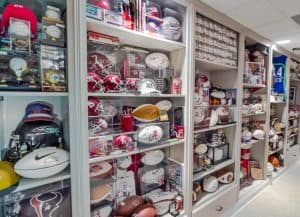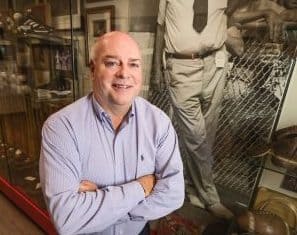EDITOR’S NOTE: Scott Myers is vice president of asset protection for Hibbett Sports. For much of his 22 years with the company, he held the dual role of vice president of human resources and asset protection. Prior to Hibbett, Myers held multiple LP positions with Parisian.
EDITOR: How did you get started in loss prevention?
MYERS: I got into it by accident. I was in college at the University of North Alabama, which is located in Florence, AL. I had two roommates who worked at Sears, and they came home one day and said, They’ve got a position open in the security department. You should apply. And I said, But I don’t know anything about security. I applied anyway, got the job, and stayed there for three months until Parisian department store, which was located in the same mall, hired me away. I stayed with Parisian for nine years. I worked in nine of their stores before going to their corporate office. So that’s how my LP career got started.
EDITOR: What did you do in their corporate office?
MYERS: Joe Hardman, who is my mentor, was their director of loss prevention at the time. I was working in the Mobile, Alabama, store, and Joe was looking to create a regional loss prevention manager position in the corporate office and brought me in with him. I stayed with him for a couple of years until I was promoted to the director of operations, which was where I ended my stay with Parisian. The company had gone through some downsizing, and I had the opportunity to go back into the loss prevention department. But to do that, I would have had to move, and I had relocated six times in nine years. I just didn’t want to move again.
EDITOR: You got into the industry by accident, but you’re still here after all these years. What was it that caused you to like what you were doing enough to maintain a lifetime career in LP?
MYERS: I liked that there was a different challenge every day. It was never boring. I liked knowing you could have a positive or negative impact on the companys financial success by the way you did your job. There was always something happening, and I like seeing things change and evolve. I like watching processes and technologies grow. I enjoyed the interaction with people, which is still true today. Its always interesting to be around people, good or bad.
EDITOR: How did you finally make it to Hibbett?
MYERS: After Parisian, I made a brief stop at a company called Simply Fashion Stores. I was there for a year and a half. Then, in early 1995, a vendor let me know that Hibbett was considering starting a loss prevention department and encouraged me to interview. So I sent them a resume.
The person who ended up hiring me is someone who has really meant a lot to me here, a gentleman by the name of Mickey Newsome. Mr. Newsome is our chairman of the board to this day, and at the time in 1995, he was our president and CEO. I remember one of the first things he said to Hibbett Sports store employees was, Your first job with the company is to protect the assets of the company. I’ve always thought that was a strong statement. People will say, Well, shouldn’t your first responsibility be to sell? Absolutely it should be, but if you don’t have the product, you cant sell it.

I give him a lot of credit for the success that weve had not only in the company but also as an asset protection department because controlling shrink was very important to him, and that importance resonated throughout the organization. So I began working at Hibbett on August 7th of 1995 and started the loss prevention department here some 22 years ago now.
EDITOR: Can you give us some background about the history of Hibbett Sports store?
MYERS: Well, its kind of ironic. As I mentioned, I started my LP career in Florence, AL. Ironically, Hibbett Sports started in Florence some 72 years ago as Dixie Supply Company. The company sold all kinds of things back then, not just sporting goods. They actually sold airplanes at one time because somebody thought that folks coming back from the war would want to have their own planes. That didn’t exactly work out how they thought. But they made the rest of it work. Then the Anderson family, which also started Books-a-Million, bought us in 1980 and took us public in 1996. And thats where we’ve been ever since.
EDITOR: You’re headquartered in Birmingham, correct?
MYERS: Yes, in Birmingham, Alabama. When I started we had sixty stores. We have almost 1,100 now.
EDITOR: What is the typical size of a store? What merchandise do you carry?
MYERS: I’d say the average is about 5,000 square feet. The merchandise selection depends a lot on where the stores located. We have some fashion stores that cater more to fashion footwear and fashion apparel. We have athletic and sports stores that are focused on athletic apparel, athletic footwear, and team sports. We don’t carry individual sport merchandise. For example, we don’t carry golf, tennis, hunting, or fishing items. We’re baseball, football, basketball, softball, and soccer. Those are the team sports that we traditionally carry.

EDITOR: When you went over there to start the loss prevention department, were you building on anything or was it just you?
MYERS: It was just me and one other person, whose job was to process return checks. This was a very antiquated process. There weren’t any real proactive shrinkage control processes in place. Shrink was very high, and we needed that to change quickly as we were preparing to go public in 1996.
EDITOR: Over those 22 years that you’ve been in Hibbett Sports store operations, have you had any responsibilities other than loss prevention?
MYERS: Yes, I was given the human resources department in 2000 because I was heavily involved in the hiring process. Controlling shrink starts with the hiring process. Actually, we didn’t really have an HR department; what we had was a benefits department that we needed to turn it into a true HR department. The first person that I promoted as director of HR was one of our regional loss prevention managers Harvey Knighten. I went to him and said, You may think Im crazy, but now that I’ve got HR, I’m going to need a director of HR. Would you be interested? At that point in time, neither one of us were what I would call experts in HR, but we held each others hand and learned it together, and he is still with us today as our vice president of HR.
So after I was given that responsibility in 2000, I held onto it for the next seventeen years until very recently when we split the HR department off. I really enjoyed the HR world. There are a lot of similarities to me between it and LP. They’re departments of ethics and integrity. They’re departments that operate off of structure, whether it be regulations, laws, or company policies. They are departments that can make tough decisions on fact versus emotions. I really enjoyed those seventeen years. I found working on the HR side of the business very rewarding.
EDITOR: Having human resources responsibilities alongside LP is very uncommon. Do you know of anybody else in the industry who has ever had both of those responsibilities?
MYERS: We talked a lot about that early on. People would say to me, That’s kind of unusual, isn’t it? And it was unusual, but not to the degree that it is today. At one time, there were twelve or so people in retail that I was aware of that had both of those areas of responsibility. Whether they still have them or not, I’m not sure. A lot of companies decided that it was time to split those teams up as they grew.

EDITOR: In years past, LP was more involved in performing background checks and other pre-employment processes. Are you also responsible for that?
MYERS: Thats actually how I ended up with HR to begin with. LP had been really heavily involved in the pre-employment process. I remember early on we were doing credit checks, criminal checks, store mutual association checks, pencil-and-paper honesty tests, and drug testing. Regulations have changed over the years that have limited what you can and cant do during the onboarding process, so its different now. But there was some significant overlap back then.
EDITOR: As you look at your asset protection organization today, how is it divided up? How many direct reports do you have?
MYER: I have five direct reports. We are broken up into two AP regions—west and east. We have 23 regional asset protection managers out in the field covering forty to 45 stores each. Each time we add another forty stores, the company allows me to hire another regional asset protection manager.
One thing I’m as proud of as anything is that out of those 23, we only have three people on our team who grew up in the loss prevention world. Everybody else was a former store manager for us or, as we call them, a head coach.
EDITOR: What caused you to build the organization like that?
MYERS: In the beginning, I think we just didn’t know what we didn’t know from the organization standpoint. I had a good feeling of what we needed, but I think the company was asking, Do we really need to go out and get experienced people? Can we do it from within? And I said, I don’t know. Let’s give it a shot.
And what we found out was that they were already Hibbett-ized, meaning they already understood the company culture. They could really help the head coach from day one because they had been an experienced head coach themselves. They were someone who had produced good shrink results, who had operated a store very efficiently. So from day one they could help them be the best head coach they could be. That was really what the game plan was all along.
We found out that we could teach them the loss prevention part along the way, and thats what we’ve done. Were looking for somebody who has had a great track record of running a successful store. And we’ve been able to teach them how to do the LP stuff, and its worked out great for us. We have very little turnover on our team, and hopefully that will continue to be the case for years to come.
Read the rest of this interview to learn more about the Hibbett Sports store team’s greatest accomplishments [and Myers’ magnificent sports memorabilia collection] in the full article, “Collecting Shrinkage Goals and Sport Memorabilia,” which was originally published in 2017. This excerpt was updated July 17, 2018.


